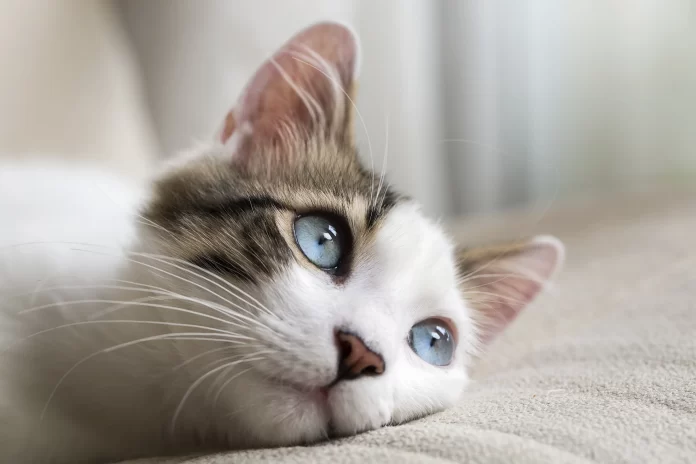Last Updated on August 21, 2023 by Fumipets
Can Cats See Color?
Cats have long fascinated us with their unique sensory abilities, and one question that often arises is whether cats can see colors like humans do. While their vision differs from ours, it’s not a black-and-white scenario. Let’s delve into the intriguing world of feline vision and explore the question: Can cats see color?
Cats
Markers, colorful plush toys, and sparkling crinkle balls. Although each of these toys features vibrant colors, they might not be utilizing what a cat can actually see. If you share your home with a fluffy feline, you are aware of how much cats like pursuing, pouncing on, and catching various objects. They have an instinctive ability to grip your ankles as you get out of bed or capture that pesky fly. A cat was not designed to choose a favorite toy just because it was red, however.
Cats perceive fewer colors than humans do, but they have an incredible capacity for detecting little, quick motions with a considerably broader field of vision. Additionally, they have a special ability to see in the dark, which makes them excellent nighttime hunters.
What Is Color Blindness?
Color blindness is a term used to describe someone who has trouble distinguishing between different colors and has nothing to do with their ability to see. It’s not unusual for someone to be unable to tell the difference between red and green. Others find it challenging to distinguish between shades of colors or to compare colors after an eye injury or sickness. The cause of this is color blindness. Cats do not lack an eye in and of themselves.
Cones and rods are the two different kinds of color receptors found in the eyes of both people and cats. The cones are responsible for daytime vision and color perception. Rods address peripheral vision, which is the capacity to look in all directions and at night. The light’s wavelengths are detected by each cone. Since humans have three cones, they can typically detect the entire light spectrum. Cats can only perceive a limited range of light since they only have two cones.
Can Cats See Color?
Although some colors are visible to our feline friends, are there any that they see best? Cats can perceive yellow-green and blue-violet wavelengths of light, but not red-orange, thanks to their two color-detecting cones. So, like dogs, cats primarily perceive objects in hues of yellow, gray, and blue, though some researchers speculate that they may also pick up on some shades of green.
Therefore, a laser pointer that you tease your cat with nonstop is not a good choice for playtime. Please choose another toy. Your cat most likely doesn’t notice how brilliant that red is, focusing instead on the light’s rapid, bouncing action. Not to add that chasing an impossible aim for so long is irritating for them.
If you want to see like a cat does, check out these cat perspective images.
How Do We Know Cats Aren’t Color Blind?
Although we can’t directly ask a cat what colors inspire them, we do know that they are extraordinary animals with incredible eyes! Recent studies have made fascinating findings about all the amazing things a cat’s eyes are capable of seeing and doing. Cat vision simulators have been used in several research, giving us an idea of how real cats see. There have also been experiments to see whether animals, such cats, can recognize colors using food and color panels. To get a food incentive, the animal might choose one hue over another.
What Does This Mean for Your Cat?
Beyond the fact that unfair, unwinnable games are created for your cat by toys like laser pointers (seriously, stop it! ), toys with vibrant colors won’t stimulate your cat in the same way that toys with movement will. The greatest toy for a cat is one that appeals to their natural predator tendencies, but if you also want to choose something attractive, your best chance is something in the hues of yellow, blue, and maybe green.
Your cat may not be able to see all the colors of the rainbows, but she is a skilled midnight hunter. Crepuscular, or active at dawn and dusk, is the term used to describe cats. You should be aware that your cat will undoubtedly notice anything that moves if you allow them outdoors (it’s safer to keep Meowmers indoors).
Cats have a “tapetum lucidum—or a thin reflective layer along the back of their eye that ‘bounces’ and magnifies light in dark places,” according to Alicen Tracey, DVM of Den Herder Veterinary Hospital in Waterloo, Iowa. According to Tracey, this reflecting coating is the cause of the eyes’ propensity to “shine” in the dark in dogs and cats.
Due to their intrinsic ability to see in the dark, cats may wreak havoc outside by killing a variety of small animals, including local bird species. Therefore, you must keep an eye on your little panther because of how keenly they can see other animals.
Questions & Answers: Can Cats See Color?
Can cats see any colors at all?
Yes, cats can see some colors, but their spectrum is more limited compared to humans. They primarily perceive colors in the blue and green range, while reds and pinks appear as shades of gray.
How do cats’ eyes differ from human eyes in perceiving color?
Cats have fewer color-detecting cells called cones in their retinas compared to humans. Humans have three types of cones, enabling us to see a wide range of colors. Cats, on the other hand, have two types of cones, affecting their color perception.
Why is a cat’s color vision limited?
Cats are crepuscular predators, which means they’re most active during dawn and dusk. Their evolutionary history prioritized detecting movement and contrast rather than a full range of colors, aiding them in hunting during low-light conditions.
Can cats see in the dark?
Cats possess a remarkable adaptation known as the tapetum lucidum, a reflective layer behind their retinas. This layer enhances their ability to see in low-light conditions by reflecting light back through their retinas, giving them superior night vision.
Do color differences impact cats’ behavior or preferences?
Cats rely on other senses, such as scent and hearing, more than vision. While they might not have the same appreciation for the nuances of color as humans, they can still differentiate between shades and patterns. However, their behavior is influenced more by contrasts and motion than by specific colors.
In conclusion, while cats do perceive some colors, their vision is different from humans’. They excel in low-light conditions and detecting movement, making them skilled hunters. Understanding their unique visual abilities adds to our appreciation of these enigmatic creatures.

















